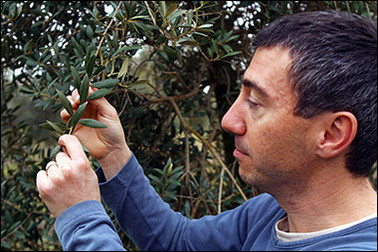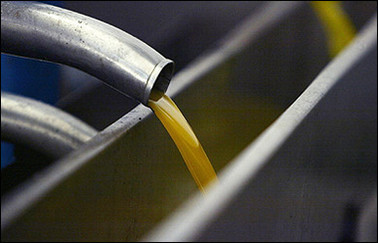Spain’s love affair with olive oil
March 9, 2006 - Agence France Presse

If Spain were to choose a food product to fuel its country, it would be olive oil, hands down.
It’s even easy to get the feeling that people here don’t quite know what to do with butter. Go into a supermarket in Barcelona and it tends to be tricky to find, unsalted butter and, curiously, sometimes tastes a bit like cheese.
But despite being the largest olive oil producer in the world, high-quality olive oil from Spain seems to be something that has fallen off the radar screens of foodies outside of the country.
Internationally, French and Italian oils get most of the attention, yet according to Madrid’s International Olive Oil Council, Spain will produce about 880,000 tonnes of the estimated 2.5 million tonnes global production in 2005/2006, with Italy in second place with about 600,000 tonnes.
France, despite being well-known for high-quality oil, produces a negligible amount on a global scale.
For agricultural engineer Jose Luis Juan, quality begins in the orchard.
“Olive trees are very grateful. When they feel well, they will give you a lot of fruit and good olive oil,” said Juan, who works at Dauro olive oil, which straddles a pair of tiny towns near Girona.
“We use technology, but only what is necessary.”
Dauro, which produces some 70,000 liters (15,400 gallons) on its 103 hectares (254 acres), is owned by Mario Rottlant, the region’s Coca-Cola distributor, but he has little time to tend to his olives, allowing Juan and his colleagues to take the reins.
As a botanist, Juan spent years working with apple trees before switching over to olives.
He points to a photo showing the Dauro trees with nothing but dirt between each row. “That’s what it used to be like here,” he said.
The dirt space is now filled with green. “With the green in the middle (a mix of grass and weeds), there is more equilibrium between the trees and the earth, and you have less pest control to worry about.”
As ash from the giant February pruning fire floats from the sky, he added: “You can manage them in some ways, but it’s the tree that decides. They are the ones that manage you.”
 Freshly-pressed olive oil pouring out of a spigot at a plant in Jaen, Spain. According to Madrid’s International Olive Oil Council, Spain will produce about 880,000 tonnes of the estimated 2.5 million tonnes global production in 2005/2006, with Italy in second place with about 600,000 tonnes(AFP/File/Cristina Quickler)
Freshly-pressed olive oil pouring out of a spigot at a plant in Jaen, Spain. According to Madrid’s International Olive Oil Council, Spain will produce about 880,000 tonnes of the estimated 2.5 million tonnes global production in 2005/2006, with Italy in second place with about 600,000 tonnes(AFP/File/Cristina Quickler)Back inside, he demonstrated how they get the oil from the olives. First, they are cleaned and crushed different ways, and the resulting paste is mixed and warmed before it goes to a pair of centrifuges that extract the oil.
Juan doesn’t stop there. As if blending a wine, he mixed a variety of olives—Arbequina, Koroneiki and Hojiblanca varieties—before capping the bottle.
The Arbequina tastes light and fragrant with hints of tomato and artichoke, Hojiblanca provides fruitiness and the darker-colored Koroneiki oil links the two.
Some 200 kilometres (120 miles) away in the town of Arbeca is Joan Gras, a farmer and the president of the local olive oil cooperative.
While Dauro exports most of its production, the Cooperativa del Camp L’Arbequina d’Arbeca is the inverse. Hardly any of its oil leaves the area immediately surrounding where it is made.
“Everything comes from the village within four or five kilometers from right here,” said Gras.
About 300 farmers, often retired, grow and harvest their olives on small parcels before bringing them to the co-op for processing.
It’s a hands-off growing style that is typical of a cooperative and the kind of thing that might drive Dauro’s Juan crazy.
“How do we know we’re getting good olives?” asked Gras, while pointing to his eye. “We look. If they’re not good, we can see it.”
“Our engineers can also tell who’s doing good work and who isn’t,” said co-op manager, Jesus Rue, who explained that closer attention is paid to the few farmers whose olives have been below par in the past.
“In 2001, we had to say ‘no’ to all of the olives that came in after a big frost,” added Rue. All of the frostbit olives from that year were sold to another company which turned them into supermarket oil.
The cooperative, which produces annually about 200,000 liters of oil, also has incentives to push its farmers to pick their grapes when they’re at their best, not just when they weigh the most.
The oil is sold to the townspeople, Gras included. At his home, where he’s quite a cook, there’s no butter in the fridge, and no other types of oil to be found.
One of the pillars of Catalan food culture is the simple and addictive “pa amb tomaquet” or tomato bread, which is stale or toasted bread rubbed with tomato halves, perhaps a bit of garlic, then drizzled with olive oil.
Eschewing toast and jam, a true Catalan breakfast consists of anchovies on tomato bread, washed down with a cup of milky coffee.
THIS STORY ALSO RAN WITH: Yahoo News, Todayonline.com